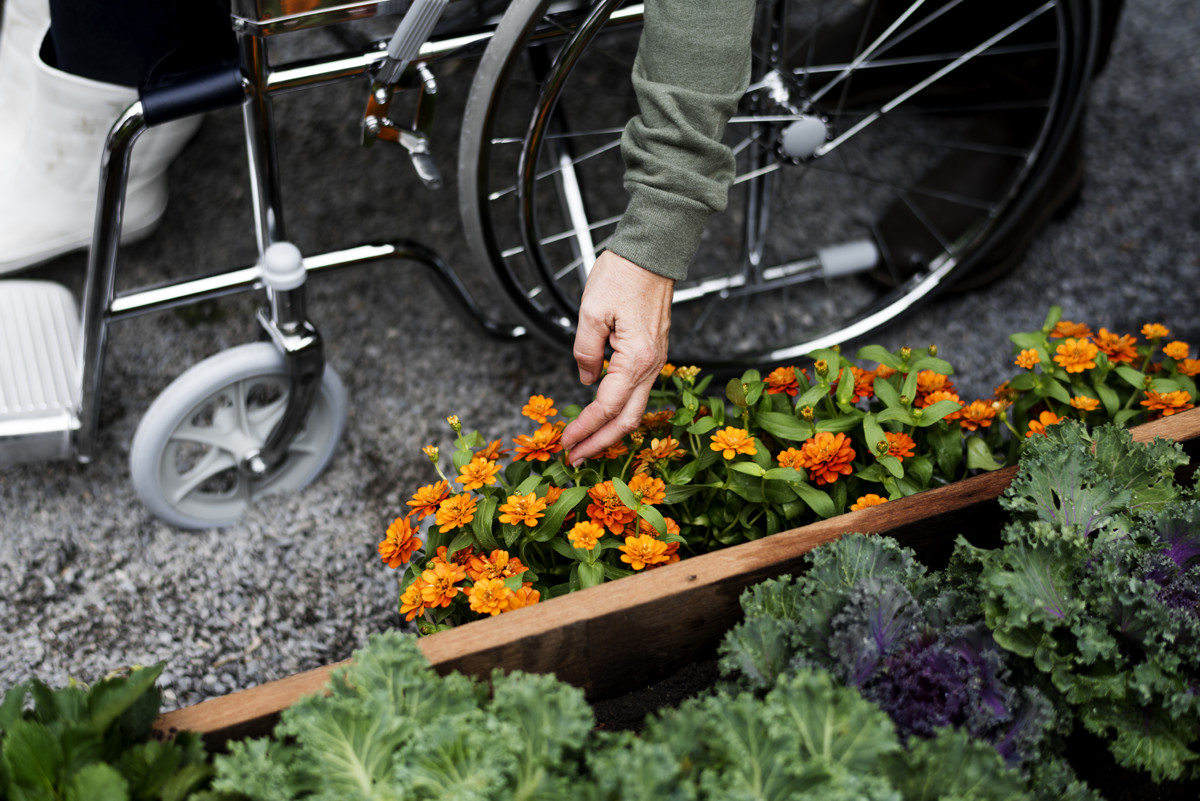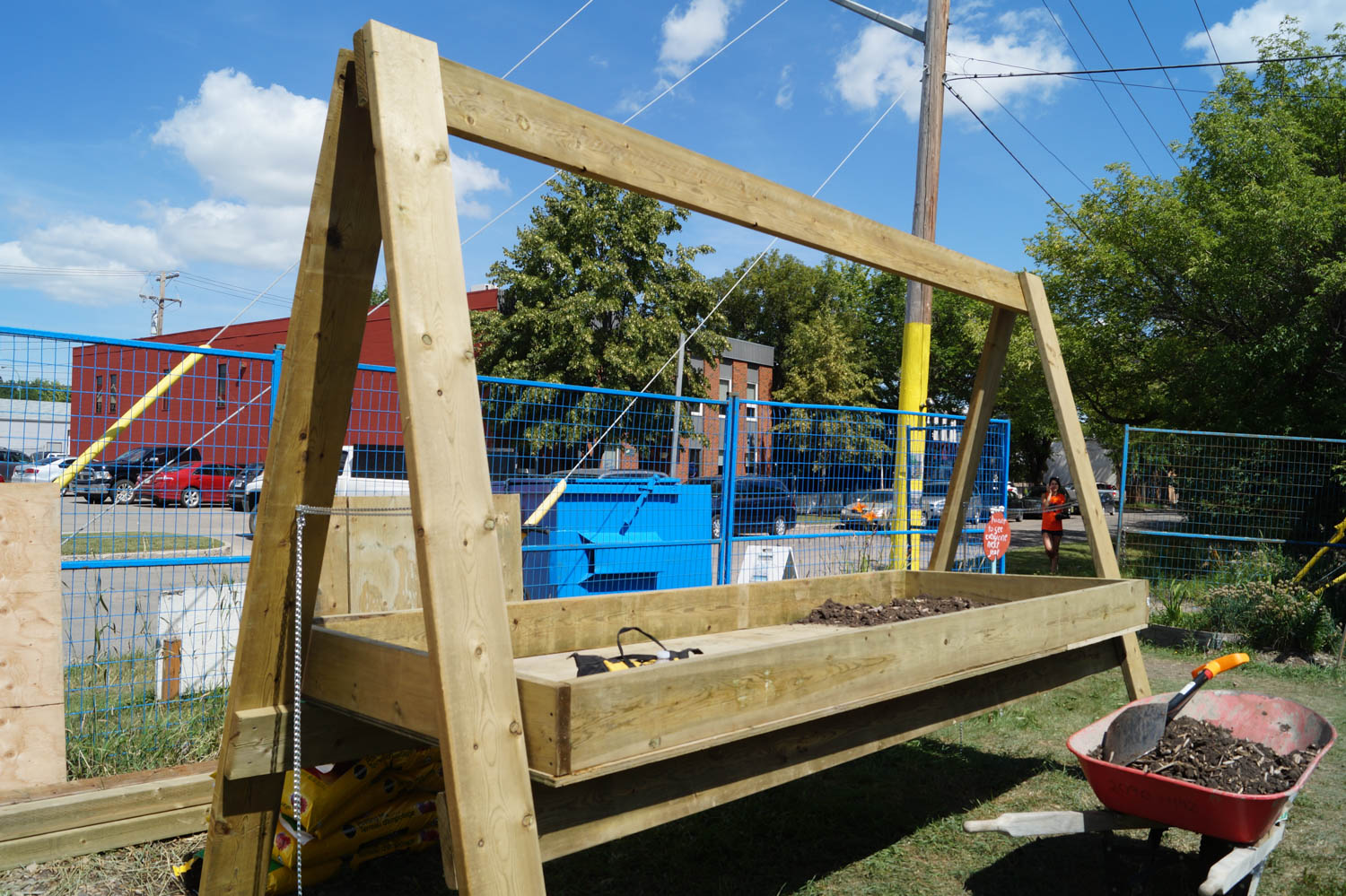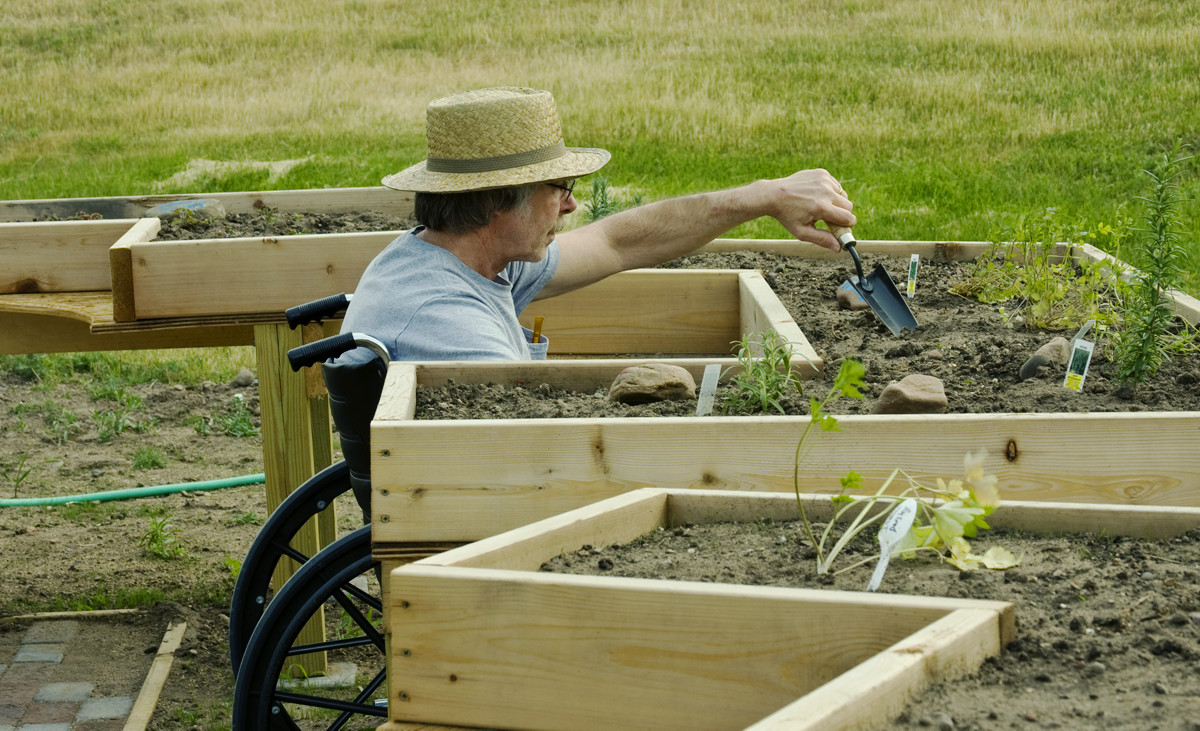
Accessible gardening
in partnership with Spinal Cord Injury Saskatchewan
Everyone – regardless of ability – can enjoy gardening. There are many ways to bridge challenges like mobility, injury, illness, sensory or age-related conditions so that you can garden more easily. What follows is a toolkit of ideas to make gardening accessible to everyone. Experiment to find what works best for you. If you are assisting a gardener with making an accessible garden, listen carefully and work closely with them to find what is best. It is critical that the garden is customized to the needs of the gardener. After reviewing some site considerations, we will be discussing containers, raised beds, and elevated garden planters. Whichever meets your specific needs best, place your garden where there is good sunlight, access to water and stable walkways. Plan ahead, building your pathways before installing your grow boxes.
Primary Considerations
Walkways
Walkways
Consider the location of walkways before installing raised beds or large containers.
- Hard, even, slip-resistant surfaces are a must if you use a walker, cane, wheelchair or scooter.
- Cobblestone and paving stone are very aesthetically pleasing but can shift and make manoeuvring with mobility devices difficult. Poured concrete or a rubberized service (like one made from recycled tires) work well.
- Avoid steep slopes for your walkway if you can. A natural slope more than 1” of rise over 20” in length may be difficult. For detailed ramp construction, see this fact sheet.
- Take advantage of existing hard surfaces like patios, sidewalks and driveways. Situate raised beds or large containers next to them to reduce costs. Make sure it is a sunny spot.
- The width of a walkway should be comfortably wider than you and your wheelchair. 42” is the minimum width, but 48” or wider is recommended.
- Make paths even wider – 60” - if you need to accommodate a service dog or sighted guide.
- Try to design your walkway so that it brings you back to your starting point without having to turn around.
- Otherwise, plan for a logical place to turn around. A space that is 60” by 60” is the minimum for a wheelchair or walker. If you use a larger wheelchair or a scooter, space should be at least 83” by 83”.
- If you have limited vision, use a line of contrasting paint or other markers to mark paths to orient you in the garden.
- Fragrant plants such as nicotiana or plants with distinctive shapes like a round cedar can help to orient where you are in your garden.
- Install sturdy, free-standing handrails for support.
- Include places to sit throughout the garden. Make sure there is a shady spot to rest on a hot day.
Low vision? Use sound and pathway lighting
Watering
This can be a challenge – water is very heavy! Watering cans and garden hoses may be too heavy to lift or move. It’s best to garden near a water source.
- Mulch your soil – you can mulch any garden soil including raised beds, containers and even pots. This will prevent evaporation, reduce weeding and it’s good for your soil!
- Consider installing drip irrigation or soaker hoses in your garden beds or raised beds. Drip irrigation works well for containers too.
- Attach a hose along the top of a raised bed to make water more accessible.
- Secure hoses with hose guide so they are not a tripping hazard. Keep in mind that brightly coloured hoses are easier to see.
- Lightweight hoses which collapse into a coil are lightweight when not filled.
- Attach a long-handled water wand with a rain spigot for watering. Install wooden rests in key areas to help bear the weight.
- A pliable tap grip such as this one makes turning water faucets easier.
- Lever-style shut off valves can be attached to a standard faucet. Look for one with a plastic-coated lever. These are easier to turn off and on than a standard round faucet handle
Growing Options
Containers
Gardening in containers is a great way to grow flowers and vegetables.
- Plastic or terracotta pots make good containers. Be creative: you can use anything for decorative plants – an old rubber boot, a doll stroller, a burlap coffee sack and more. As long as it can hold moist soil and has drainage holes in the bottom, it can work. Never plant edible plants in a container that could potentially toxify your food such as old railway ties or tires.
- Set containers on something sturdy to raise them to an accessible height. Use bricks, wooden boxes, up-turned pots, or set containers on a small table, bookcase or bench.
- Set large pots on wheeled dollies made for plant pots.
- For more information on container gardening, see this article.
Raised Beds
Raised beds are large planter boxes that are tall enough for you to reach when sitting or standing if you have difficulty bending.
- The overall height of your raised beds should be customized to fit the height of the person who is using them and the way that they want to work at them. A person who sits low to the ground will not benefit from a standing bed and vice versa. A comfortable starting point is 32”, though whatever your needs are, ensure that you maintain about 18” or more of soil depth.
- When designing the raised bed, consider how far you have to reach to get to the middle of the bed. 18” should be the maximum reach to the centre of a bed. E, S, T, U, or W shaped beds are easier to reach into than square or rectangular beds.
- Install a wide seat along the edge of the planter so you can sit when gardening.
- Install lengths of coated wire across the short end of the planter to locate your plants easily if you have limited vision. Attach with screws drilled into the edge and wrap the ends of the wire with electrical tape so they don’t scratch.
- All beds should be accessible from a good walkway.

Elevated Garden Planter
An elevated garden planter is simply a square or rectangular shallow box on raised legs so that a chair or wheelchair can fit comfortably under the planter. In this way, you can get close to the plants without having to reach over from an awkward position. Tables are available commercially, but anyone with basic carpentry skills can build one.
Keep in mind:
- The box should measure at least 2’ by 2’ across. It can be longer or wider if you want.
- The box should be between 8” and 10” deep. The bottom of the box should have drainage holes.
- The legs need to be sturdy enough to bear the weight of the soilless mix, water and plants.
- To determine the height of the space under the box:
- Measure the distance between the ground and the top of your legs when sitting and add 3” of clearance.
- If you prefer to allow the armrests of your wheelchair to fit under the box, measure the distance between the ground and the top of your armrest and add 2” of clearance.
- The total height of the planter should be 35” - 37”. The top of the planter should be no higher than your ribcage.
Here is a link to a set of free plans for a 4’ by 8’ raised planter box. It features a design for extremely sturdy leg supports. You will need to adjust the height of the legs in this plan to customize it for you.

Vertical Gardening
If you have wall space on a balcony or patio or even a fence, vertical gardening may be for you.
- A wide variety of vertical wall systems are commercially available. Some are as simple as plastic bags attached to walls; others are made of wood.
- Attach a trellis to a wall or fence.
- Hanging baskets are a good option. Use a pulley system to easily reach your plants.
- Make your own vertical garden using short lengths of gutter. Attach end caps and drill holes in the bottom of the gutter. Either screw the gutter on to a fence or wall or hang it with nylon rope.
- There are lots of other ideas for homemade vertical gardens on the internet or check out our samples on this page.
Tools
Every gardener needs tools such as pruners, trowels and planting spades. If possible, try before you buy - one size does not fit all. Select tools you find comfortable and easy to use. What to look for:
- Choose lightweight tools. Tool blades made of aluminium are light and strong. Small tools designed for children may be good for small jobs, but plastic is not durable and may not stand up to heavier jobs.
- Consider the length of the handle on hand tools. A long handle is good for reaching across a raised bed, while a short handle gives more comfortable leverage for digging small planting holes. Telescoping handles can be adjusted to suit different jobs.
- Ergonomically-designed tools are widely available. They often feature thick, contoured grips and curved handles. Some have special mechanisms for squeezing, such as scissors or pruners. These are usually well-designed but can be expensive. You might be able to adapt your own tools to have a softer, wider, more comfortable grip using piping insulation. This pre-slit foam tubing is used to prevent pipes from freezing in the winter and is available inexpensively at most hardware stores. Simply cut it to the length of your grip, slide it around the handle and fasten it securely using duct tape or glue. The 3/4" size of pipe insulation fits most hand tools; smaller sizes are recommended for tools with smaller grips such as pruners.
- There are many adaptive devices for users with disabilities affecting hand and finger dexterity, such as those shown on the Active Hands website, and PETA. Both companies are based in the UK, but the products work well.
- For longer tools such as digging spades or forks, an O-shaped or T-shaped handle is easier to hold with two hands. Or, look for a D-shaped handle with the largest opening you can find.
- A good alternative to a trowel is a hand-held soil scoop. An aluminium blade that comes to a point with a serrated edge makes digging small planting holes easier and more precise.
- Wear a good-fitting pair of rubberized garden gloves for better grip and to protect your hands.
- Kneeler stools are widely available. It can be used as a low seat or provide a cushioned surface to kneel on. The built-in handles make getting up or down more stable.
- Tools for pruning or cutting require a squeezing motion which can be difficult for some. Ergonomically-designed tools are great but cleaning, lubricating and sharpening the tools you already own make them much easier to use.
- Medical supply stores sell grips, cuff supports and velcro straps which can be used to adapt tools for ease of use.
- Store your tools in a convenient, sheltered spot. Hang tools from pegs on your raised beds.
Carrying things in the garden
There always seems to be something that needs moving in the garden: plants, soil, supplies and produce at harvest-time.
- A wicker basket with a handle is useful for small, lightweight items.
- Lightweight rubber buckets with built-in handles come in a variety of colours.
- A lightweight tool belt is useful for carrying small tools, seeds and other supplies.
- A wheelchair lap tray is helpful to store tools you are currently using.
- Install a tray or basket mount on your walker, wheelchair or scooter. Line your basket with plastic if you need to move wet or muddy objects.
- Use a small wagon to haul larger items. Wheels that swivel are easier for turning.
Sources
http://www.carryongardening.org.uk/top-tips-for-disabled-gardeners.aspx
https://www.christopherreeve.org/living-with-paralysis/health/staying-active/accessible-gardening
http://community-gardens.ca/content/accessible-gardens
CMHC Accessible Housing by Design: Exterior spaces https://www03.cmhc-schl.gc.ca/catalog/productDetail.cfm?lang=en&cat=17&itm=69&fr=1510674970574
CMHC Accessible Housing by Design: Ramps https://www03.cmhc-schl.gc.ca/catalog/productDetail.cfm?lang=en&cat=17&itm=59&fr=1510674970574

